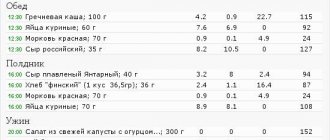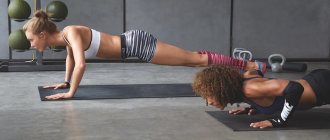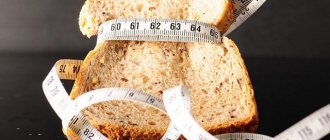How much body fat should you have?
Previously, men (and even some women) set their main goal to build muscles. But times are changing and now the main thing is “lean” mass, namely getting rid of fat mass in order to maximize muscle manifestation. Just think of Brad Pitt in Fight Club or Cristiano Ronaldo at any point in the last ten years. Pronounced muscles, not fat tissue.
A similar figure - lean body mass, without excess deposits - has recently become the main goal of trainers and gym visitors. But even if you are not striving for such pronounced muscles, it is worth finding out what percentage of body fat is normal and whether you need to change it, since this amount is one of the main indicators of the health of the body.
“Having a normal percentage of body fat reduces the risk of developing a variety of diseases,” explains Dr Luke Powles from Bupa's Crossrail Medical Center in London.
“Higher body fat has been shown time and time again to increase cholesterol and blood pressure, both of which are risk factors for cardiovascular disease. This condition can also cause certain types of cancer and diabetes. In men, high body fat leads to erectile dysfunction.
But the percentage of body fat to muscle mass should not be too low, since underweight also leads to the development of a number of diseases.”
How much fat should you ideally have? For men aged 20-39 years old, the norm of body fat varies from 8 to 20%, for men aged 40-59 – from 11 to 22%. Now it’s much easier to find out your body fat percentage: smart scales, pocket scanners and fitness trackers can easily provide all the information about your body composition. For conservatives (or budget-conscious) there is also an option - a caliper.
Before you start losing fat, it's worth learning a little about the biological processes behind it. Let's start with the two types of fat: essential and stored.
Obesity and too much body fat
- A body fat percentage of 30% is the limit for women, 35% is already clinical obesity. While in men the limit is 25%, obesity is 30%.
- High levels of body fat are a risk factor for many diseases, including heart disease, stroke, high blood pressure, diabetes, some cancers and osteoarthritis.
- Excess fat makes it difficult to achieve results in sports. High body fat is a type of “dead weight” that leads to decreased performance in speed, endurance, movement efficiency, agility, balance and jumping ability. However, if you are overweight you should not avoid exercise, just follow some simple exercise tips provided on this site.
Accumulated fat
Another type - accumulated - is the result of excess calories consumed. When we eat, calories that are not immediately used for functioning (such as providing energy for breathing or maintaining heart rate) are converted into triglycerides, which make up stored fat. Frequent excess calories, which cause fat accumulation, lead to weight gain. On the other hand, a repeated calorie deficit forces the body to use stored fat mass as energy, depleting reserves and leading to weight loss.
Body fat percentage
Simply put, fat is unused energy that is life-threatening. Its percentage in the body is the ratio of fat mass to total body weight. Returning to the question of what percentage of fat a person should have in the body, it should be noted that this number is influenced by many factors, such as height, gender and heredity. A "healthy" percentage for men aged 20 to 40 is generally considered to be no less than 8% and no more than 20%. A healthy woman in the same age group should have a body fat percentage between 15% and 31%. These figures are based on November 2020 data from the Royal College of Nursing.
Visceral and subcutaneous fat: norms
In the human body, fat is divided into
- visceral, which is located inside the body and is invisible to the naked eye;
- subcutaneous, which is located just under the skin and is easily visible.
Visceral deposits are necessary for the full functioning of the body; it covers the internal organs and cavities. Excess of its norm can be determined by body imbalances: with an excess, the stomach protrudes significantly.
Important! It is subcutaneous fat that you need to get rid of to lose weight. However, as a percentage, the visceral layer of the total fat mass should be no more than 15%.
Table of body fat percentage for men of different age groups
| Category | 20-39 years old | 40-59 years old | 60-79 years old |
| Low fat percentage | < 8% | < 11% | < 13% |
| Healthy body fat percentage | 8-20% | 11-22% | 13-25% |
| Increased fat percentage | 20-25% | 22-28% | 25-30% |
| High percentage of fat | > 25% | > 28% | > 30% |
Most people can be guided by these indicators, but it should be remembered that the table does not take into account everyone’s individual fitness goals. Bodybuilders typically aim for ultra-lean muscle mass and a body fat percentage of no more than 5-8%. Cyclists and gymnasts are among the leanest athletes and typically have between 5 and 12% body fat. In order to look as prominent as possible, the indicator should be from 5 to 10%.
How to calculate the amount of fat in your “ideal body”?
- Smart floor scales (body composition scales)
- Fat loss monitor
These are the simplest ways. These instruments use a technique called bioimpedance testing (BIA), which involves measuring the resistance of different areas of the body to electrical current. Muscles are good conductors of electricity because they are 70% water. Fat conducts current worse. The worse the body passes current, the more fatty tissue it contains.
This sounds pretty reasonable, but there are serious problems with the BIA. When current passes through a body, it follows the path of least resistance. For example, through the fatty tissues of internal organs, and not subcutaneous ones. Most of these devices contain two electrodes, so even large areas of the body are often ignored.
For example, the scale may not take into account the entire upper body (electrical current will flow from leg to leg). And manual devices will miss the entire lower part. This seriously skews the results. Another problem with bioimpedance testing is that it uses mathematical equations that translate test scores into percentage body fat.
Why are their formulas not correct? When companies create BIA meters, they use another imperfect method of measuring body fat percentage, such as hydrostatic weighing. Some studies have shown that hydrostatic weighing itself can be inaccurate by 6%, depending on a person's race, nationality, etc. .
In other words, a person with 10% body content may get a result of between 4-16% on a hydrostatic weighing. Many factors influence the results. If you conduct a study in a state of dehydration, you will get a very high result due to reduced conductivity. But if you test after eating, you will get the opposite effect - the readings are too low.
Body conductivity is also better after training. Therefore, when conducting a test after physical activity, incorrect and low results are obtained. That's why these devices are not suitable for correctly estimating body fat percentage. How about purchasing one such device to track changes over time? Not good either. These devices make mistakes differently each time. There is no clear pattern.
Calipers are used to measure the thickness of skin folds in different areas of the body. These measurements are plugged into the formula. As a result, the percentage of body fat is calculated. And there are disadvantages. Grab too little skin and the readings will be too low; too much and the readings will be higher.
DXA (sometimes called DEXA) uses x-rays of the entire body. It is based on the fact that tissues containing and not containing fat absorb X-rays differently. Therefore, everything can be measured and calculated. Most people previously believed that DXA was an error-free method, but numerous studies have proven that it can be wrong by 4-8, and sometimes even 10%.
A plethysmograph (Bod Pod) is a machine that works similar to hydrostatic weighing, but uses air instead of water. Sit in a sealed capsule and a sensor measures how much air your body displaces (Archimedes' principle). Then, using mathematical formulas, this is all translated into the percentage of fat tissue in the body. Unfortunately, the accuracy of the Bod Pod method is no better than all previous ones. It is negatively affected by hair, humidity, body temperature and clothing.
As a woman ages, her metabolism slows down. Enzymes responsible for food processing are released as before, but less and less are consumed every year. To ensure that enzymes do not go to waste and participate in food processes, the body increases appetite. Women may not notice that they are consuming more calories, but body fat gradually increases like a snowball.
Also, women who have gained significant weight in the last few years should remember that they have a high risk of visceral obesity. Visceral obesity is a type of obesity in which fat is located around the internal organs. The maximum percentage of visceral fat should not exceed 15% of the total volume of adipose tissue. A larger percentage of this type of fat threatens health.
Body fat percentage is a measure of your body composition that reflects how much of your weight is fat mass. There are several ways to calculate body fat percentage and what is normal for women and men, including bioelectrical impedance analysis and other anthropometric methods. Here's a method for calculating your body fat using just your measurements and a calculator.
- 20-40 years - insufficient: less than 21%, healthy: 21-33%, overweight: 33-39%, obese: more than 39%;
- 41-60 years old - insufficient: less than 23%, healthy: 23-35%, overweight: 35-40% obesity: more than 40%;
- 61-79 years old - underweight: less than 24%, healthy: 36-42%, overweight: 36-42%, obese: more than 42%.
- 20-40 years - insufficient: less than 8%, healthy: 8-19%, overweight: 19-25%, obesity: more than 25%;
- 41-60 years old - underweight: less than 11%, healthy: 11-22%, overweight: 22-27%, obese: more than 27%;
- 61-79 years old - underweight: less than 13%, healthy: 13-25%, overweight: 25-30%, obese: more than 30%.
Try to get as accurate a result as possible. Different scales will often give different numbers, and depending on the time of day you weigh yourself, the numbers may vary. Try stepping on the scale at around the same time of day for a few days to get an average body weight.
You can easily calculate your BMI by dividing your weight in kilograms by the square of your height in meters. Example: a person weighs 68 kilograms and is 1.65 meters tall. The calculation will look like this: 68 ÷ (1.65)²= 24.98
According to a study published in the British Journal of Nutrition in 1991, if you are an adult, your body fat percentage can be estimated as accurately as screening measurements and bioelectrical tests using the following gender formulas in combination with your BMI .
Read more: Is bodybuilding or large muscle mass bad for the heart?
Women:
- (1.20 x BMI) (0.23 x Age) - 5.4 = % body fat
Men:
- (1.20 x BMI) (0.23 x Age) - 16.2 = % body fat
Step 5: Compare the percentage of step 4 and the results of step 1
Take a moment to compare the result you got in step 4 with the results reported in step 1. Comparing your results to these numbers should give you a good idea of how close or how far you are from your “ideal body fat percentage.”
If your BMI or body fat percentage is higher than you want, a small change in your lifestyle or training routine can make a big difference.
BMI and body weight
Body fat percentage is the best indicator of health. It is better suited for determining the constitution than the aging body mass index (BMI) or simply weighing. Weight can vary significantly depending on hormonal fluctuations, time of day, and the amount of food eaten and drunk before stepping on the scale.
If you are very tall and have significant muscle mass, your BMI will likely put you in the overweight or even obese category. The problem is that BMI was developed in 1832 by Belgian mathematician Adolphe Quetelet to identify the average person (determining how weight increases with height), not to identify underweight or obesity.
In the 1980s, BMI was adopted as a useful tool for determining life expectancy, and has been the bane of muscular people ever since. BMI often prevents young people from joining the police and other fitness-oriented agencies because they still use this indicator for admission. However, by measuring your body fat percentage, you are measuring the amount of fat mass, rather than getting an estimate based solely on height and weight.
Source: https://www.coachmag.co.uk/exercises/lose-weight/3809/what-is-a-healthy-body-fat-percentage
How to find out your fat percentage?
There is no exact way to say this with 100% success. There are more accurate methods, there are simple methods that show this approximately.
Identification from photographs
The fastest and easiest way. To determine your body fat percentage, you need to find a body shape that is as similar to yours as possible.
Cost: free. Pros: fast, free. Cons: requires your assessment of yourself, which is not always objective. We may unconsciously “throw off” a few pounds in our minds and compare ourselves to the slimmer version in the photo.
Using a caliper
A caliper is a special device that measures the thickness of the skin-fat folds in different parts of the body. Based on the obtained figures, the percentage of fat is determined using special tables or formulas.
Method number 1: measurements for women
1. Back of the shoulder:
the fold is taken vertically in the middle between the shoulder joint and the elbow.
2. On the side:
the fold is taken from the side diagonally in the middle between the lower rib and the hip bones.
3. On the stomach:
the fold is taken vertically at a distance of +-2.5 cm away from the navel.
We calculate the percentage of fat using the formula:
%
fat = (A-B+C) + 4.03653
, where:
A
= 0.41563 x (sum of all three folds in mm)
IN
= 0.00112 x (sum of all three folds in mm squared)
WITH
= 0.03661 x age in years
Method No. 2: measurement for women and men
We add the resulting numbers in mm and find out the percentage of subcutaneous fat using the table:
Cost: 500-800 rubles per caliper. Pros: fast, you can do it yourself at home, fairly accurate indicators. Cons: you need practice to learn how to use it correctly or someone else's help, calculations using formulas are required.
Bioimpedance analysis
A weak current is passed through the body using electrodes attached to the ankles and wrists, after which the electrical resistance of the tissue is measured. The method is based on the fact that fat mass and the rest of the “dry” body mass have different resistance.
Cost: 1000-3000 rubles in private clinics or free under the compulsory medical insurance policy in public health centers. Pros: fast, does not require any activity. Cons: price, need to visit a clinic, use of equipment of varying quality. Not always accurate indicators, since the figure may be affected by water balance (edema).
Scales with fat percentage analyzer
The principle is the same as in bioimpedance: the device passes a weak current through you and calculates tissue resistance.
Cost: 2500 - 10,000 rubles Pros: fast, suitable for regular home use. Disadvantages: the same as for bioimpedance - price, not always accurate indicators, since the figure can be affected by water balance (edema). When repeated measurements, fluid loss may show on the scale a decrease in the percentage of fat mass, although in fact it has remained unchanged.
Underwater weighing method
The method is based on Archimedes' law: a solid body immersed in water loses as much weight as the liquid it displaces. Since dry body mass and fat mass are different in density, the percentage of fat mass is determined by comparing body density after regular weighing and underwater weighing. The method is complex and rarely used.
Cost: could not be found out Pros: the most accurate method to date. Cons: Duration 45-60 minutes, difficult procedure and likely high cost. Fear of underwater diving.
Determination by body mass index from Lyle MacDonald
The method is only suitable for untrained people, i.e. for beginners who have not yet started strength training. For the lucky owners of visible muscles built in the gym beyond the “norm”, this method is not suitable.
To determine your body fat percentage, you need to know your body mass index.
BMI = weight in kg/height in square meters
For example: 50/(1.64*1.64)=18.5. Next, use the table in the picture and find your match:











